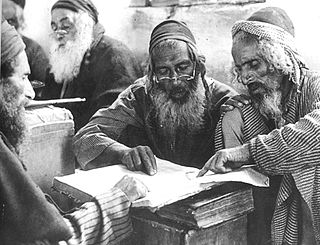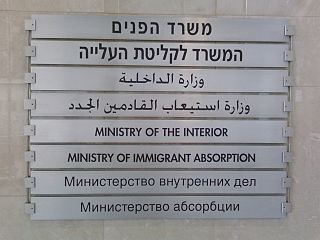The Hebrew alphabet, known variously by scholars as the Ktav Ashuri, Jewish script, square script and block script, is traditionally an abjad script used in the writing of the Hebrew language and other Jewish languages, most notably Yiddish, Ladino, Judeo-Arabic, and Judeo-Persian. In modern Hebrew, vowels are increasingly introduced. It is also used informally in Israel to write Levantine Arabic, especially among Druze. It is an offshoot of the Imperial Aramaic alphabet, which flourished during the Achaemenid Empire and which itself derives from the Phoenician alphabet.
Modern Hebrew has 25 to 27 consonants and 5 to 10 vowels, depending on the speaker and the analysis.

The demographics of Israel, monitored by the Israel Central Bureau of Statistics, encompass various attributes that define the nation's populace. Since its establishment in 1948, Israel has witnessed significant changes in its demographics. Initially formed as a homeland for the Jewish people following the Holocaust in World War II, Israel has attracted Jewish immigrants from around the globe. Consequently, the Jewish population in Israel is incredibly diverse, with roots spanning Europe, Asia, Africa, and the Americas.

The Romaniote Jews or the Romaniotes are a Greek-speaking ethnic Jewish community native to the Eastern Mediterranean. They are one of the oldest Jewish communities in existence and the oldest Jewish community in Europe. The Romaniotes have been, and remain, historically distinct from the Sephardim, some of whom settled in Ottoman Greece after the expulsion of Jews from Spain and Portugal after 1492.

Israelis are the citizens and nationals of the State of Israel. The country's populace is composed primarily of Jews and Arabs, who respectively account for 75 percent and 20 percent of the national figure; followed by other ethnic and religious minorities, who account for 5 percent.

Palestinian Arabs are the largest ethnic minority in Israel. They are Israeli citizens of Palestinian heritage and various religions, bilingual in Arabic and Hebrew, and with varying social identities. Since the 1948 exodus, the Palestinians that have remained within Israel's 1948 borders have been colloquially known as "48-Arabs". In Arabic, commonly used terms to refer to Israel's Arab population include both "48-Arab" and 48-Palestinian. In Israel itself, Arab citizens are commonly referred to as Israeli-Arabs or simply as Arabs; international media often uses the term Arab-Israeli to distinguish Arab citizens of Israel from the Palestinian Arabs residing in the Palestinian territories.

Yemenite Hebrew, also referred to as Temani Hebrew, is the pronunciation system for Hebrew traditionally used by Yemenite Jews. Yemenite Hebrew has been studied by language scholars, many of whom believe it to retain older phonetic and grammatical features lost elsewhere. Yemenite speakers of Hebrew have garnered considerable praise from language purists because of their use of grammatical features from classical Hebrew. Tunisian rabbi and scholar, Rabbi Meir Mazuz, once said of Yemenites that they are good grammarians.
Mizrahi Hebrew, or Eastern Hebrew, refers to any of the pronunciation systems for Biblical Hebrew used liturgically by Mizrahi Jews: Jews from Arab countries or east of them and with a background of Arabic, Persian or other languages of Asia. As such, Mizrahi Hebrew is actually a blanket term for many dialects.

The Hebrew language uses the Hebrew alphabet with optional vowel diacritics. The romanization of Hebrew is the use of the Latin alphabet to transliterate Hebrew words.
Al-Sayyid Bedouin Sign Language (ABSL) is a village sign language used by about 150 deaf and many hearing members of the al-Sayyid Bedouin tribe in the Negev desert of southern Israel.

The Zayit Stone is a 38-pound (17 kg) limestone boulder discovered on 15 July 2005 at Tel Zayit (Zeitah) in the Guvrin Valley, about 50 kilometres (31 mi) southwest of Jerusalem. The boulder measures 37.5 by 27 by 15.7 centimetres and was embedded in the stone wall of a building. It is the earliest known example of the complete Phoenician or Old Hebrew script as it had developed after the Bronze Age collapse out of the Proto-Canaanite alphabet.

The Israeli population is linguistically and culturally diverse. Hebrew is the country's official language, and almost the entire population speaks it either as a first language or proficiently as a second language. Its standard form, known as Modern Hebrew, is the main medium of life in Israel. Arabic is used mainly by Israel's Arab minority which comprises about one-fifth of the population. Arabic has a special status under Israeli law.

Arab localities in Israel include all population centers with a 50% or higher Arab population in Israel. East Jerusalem and Golan Heights are not internationally recognized parts of Israel proper but have been included in this list.

Ktav Stam is the specific Jewish traditional writing with which holy scrolls, tefillin and mezuzot are written. Stam is a Hebrew acronym denoting these writings, as indicated by the gershayim punctuation mark. One who writes such articles is called a sofer stam. The writing is done by means of a feather and ink onto special parchment called klaf. There exist two primary traditions in respect to the formation of the letters, Ktav HaAshkenazi and Ktav HaSefardi, however the differences between them are slight.

Yaakov Heruti was an Israeli lawyer, right wing activist and Zionist militiant. He was a member of the pre-state militant group Lehi, during which he built bombs for the organization and in particular, assembled the letter bomb that was sent to Roy Farran while stationed in Britain as an undercover agent. He later became the leader of the group Kingdom of Israel, which bombed the Soviet embassy in Tel Aviv and carried out further militant acts in the 1950s, for which he served a two-year prison term. He later became involved in politics and settlement activity, participating in the founding of two right-wing political parties and assisting settlers in purchasing land.

Nurit Yarden is an Israeli Art photographer, who lives and works in Tel Aviv. She won the Israel Ministry of Culture Prize for the Encouragement of Visual Arts in 2002.
Joseph Ginat was an Israeli anthropologist, author, political advisor, and soldier.
Basic Law: Israel as the Nation-State of the Jewish People, informally known as the Nation-State Bill or the Nationality Bill, is an Israeli Basic Law that specifies the country's significance to the Jewish people. It was passed by the Knesset—with 62 in favour, 55 against, and two abstentions—on 19 July 2018 and is largely symbolic and declarative in nature. The law outlines a number of roles and responsibilities by which Israel is bound in order to fulfill the purpose of serving as the Jews' nation-state. However, it was met with sharp backlash internationally and has been characterized as racist and undemocratic by some critics. After it was passed, several groups in the Jewish diaspora expressed concern that it was actively violating Israel's self-defined legal status as a "Jewish and democratic state" in exchange for adopting an exclusively Jewish identity. The European Union stated that the Nation-State Bill had complicated the Israeli–Palestinian peace process, while the Arab League, the Palestine Liberation Organization, the Organization of Islamic Cooperation, and the Muslim World League condemned it as a manifestation of apartheid.
Algerian Jewish Sign Language (AJSL), also known as Ghardaia Sign Language, is a moribund village sign language originally of Ghardaïa, Algeria that is now used in Israel and possibly also in France.

The Arabic language in Israel is spoken natively by over 20 percent of the Israeli population, predominantly by Israeli Arabs, but also by Jews who arrived in Israel from Arab countries. Some refer to the modern Hebrew-influenced Levantine Arabic vernacular as the "Israeli Arabic dialect" or colloquially as Aravrit, a portmanteau of the Hebrew words Ivrit and Aravit.











